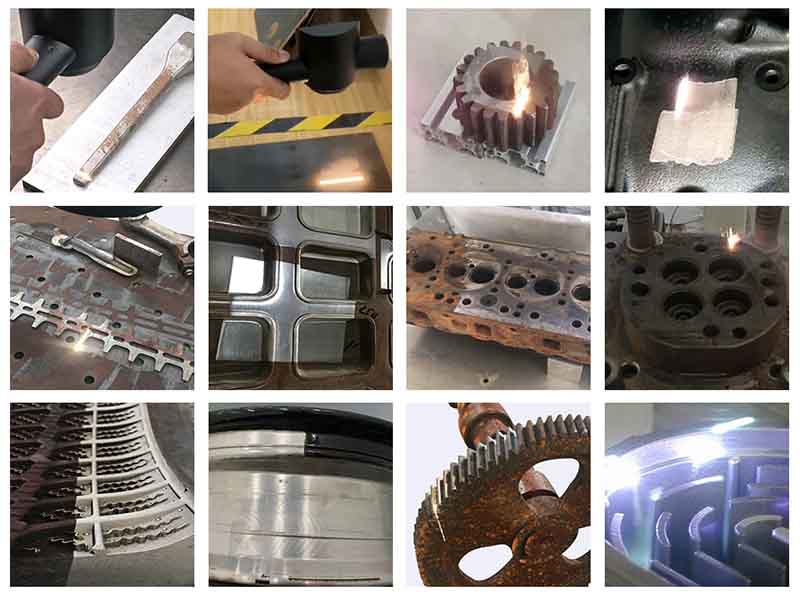In 2025, laser cleaning is becoming a preferred solution for industrial surface treatment and precision maintenance. With its efficiency, eco-friendliness, and ability to handle complex cleaning tasks, laser technology is replacing traditional methods across industries. This article explores handheld laser cleaner industrial application, the benefits, and compares some laser cleaner types to help you choose the right solution.
Laser Cleaning Applications
Laser cleaning technology utilizes a high-energy laser beam to effectively remove various surface contaminants—such as oil, rust, coatings, and paint residues—without any physical contact with the workpiece, making it especially suitable for cleaning precision components.
Organic Contaminants:
Oil and Grease: Residual lubricants or engine oil on industrial machinery and automotive parts.
Resin: Adhesive or bonding resins from manufacturing processes or resin films on electronic components.
Paints and Coatings: Paint layers on metal surfaces, car bodies, or leftover coatings on furniture.
Adhesive Films: Residual glue or bonding agents on electronic parts or adhesive layers on packaging materials.
Inorganic Contaminants:
Rust: Oxidation and rust stains on steel surfaces or building structures.
Metal Particles: Metal dust and shavings from manufacturing or automotive processing.
Dust and Debris: Industrial dust, construction site dirt, or sand particles.

Laser Cleaner Industrial Application
Laser Rust Removal on Metals
Laser cleaning efficiently removes rust from metal surfaces, restoring their original luster. The non-contact process avoids any physical damage to the base material, making it ideal for sensitive or valuable components.
Laser Paint Removal
Laser technology can precisely and quickly strip paint residues from metal or other surfaces without harming the substrate. It’s especially effective on complex shapes and small parts where traditional methods may fall short.
Laser Coating Removal
Laser cleaning offers precise removal of coatings from metal, plastic, or other materials—including paints, sprayed layers, and protective coatings. This contact-free, chemical-free process preserves the base material and improves surface adhesion for subsequent coatings or processing.
Laser Weld Cleaning
Laser systems effectively clean weld zones by removing oxides, slag, and contaminants. This enhances weld quality, ensures precision, and improves joint strength.
Micro Weld Surface Treatment
Laser cleaning plays a crucial role in refining weld surfaces by reducing roughness and significantly enhancing corrosion resistance. This is especially important for materials like stainless steel and aluminum alloys, where surface quality is critical.
Mold Cleaning (Tire, Rubber, Injection Molds)
Laser systems can efficiently remove contaminants from mold surfaces without physical contact, eliminating the risk of wear or deformation typically caused by traditional cleaning methods, and restoring the mold to its original condition.
Aerospace (Aircraft Paint Stripping)
Laser cleaning enables non-contact, chemical-free removal of old coatings, protecting the aircraft substrate and meeting the stringent standards of aerospace maintenance.
Automotive Manufacturing (Weld Residue and Mold Release Removal)
Laser technology ensures precise cleaning of welding spots and surface residues, improving coating adhesion and maintaining consistent body quality and appearance.
Shipbuilding and Maintenance
Effectively removes rust and coatings from large, complex metal surfaces, improving anti-corrosion performance and overall maintenance efficiency for marine vessels.
Electronics Manufacturing (Chip and PCB Coating Removal)
Laser cleaning offers high-precision removal of coatings and oxidation layers from circuit boards and electronic components, ensuring stability, performance, and high product yield.
Precision Machinery Manufacturing (Degreasing & Microstructure Cleaning)
In semiconductor manufacturing and precision engineering, laser cleaning is ideal for removing microscopic particles and surface contaminants from wafers and intricate components. It ensures ultra-clean surfaces to meet the strictest processing and quality standards.
Mechanical Equipment and Components
Pulsed laser cleaning systems efficiently remove grease, metal shavings, rust, and debris from equipment surfaces, helping restore original surface conditions and maintain optimal machine performance.
Chemical Equipment
Chemical processing equipment often suffers from residual chemicals and corrosive buildup. Pulsed laser cleaners are highly effective at tackling complex contaminants, ensuring safe and reliable operation.
Energy Equipment
In the energy sector, pulsed laser cleaning is widely used for power generation systems, boilers, coolers, and pipelines. It removes operational residues, enhances equipment efficiency, and prolongs service life.
Food Processing Equipment
Pulsed laser cleaning systems effectively remove grease, residues, and other contaminants from the surfaces of food processing machinery. This ensures hygienic operation and compliance with strict food industry safety standards.
Construction Materials and Equipment
Laser cleaning is ideal for restoring construction tools, machinery, graffiti-covered walls, and painted wood surfaces. It helps recover original appearances and improves maintenance efficiency across construction environments.

CO₂ Laser Cleaning Machine
CO₂ laser cleaning machines use carbon dioxide gas as the lasing medium and are available in glass tube or metal RF tube variants. Known for excellent beam directionality and frequency stability, CO₂ lasers are ideal for removing contaminants from non-metal surfaces such as adhesives, coatings, and inks.
Thanks to their unique wavelength, CO₂ lasers can precisely strip composite coatings from aluminum alloy surfaces without damaging the underlying anodized layer.
Typical applications include:
- PCB ink removal
- Adhesive cleaning on battery electrode sheets
- Tab sealing area cleaning in pouch battery packaging
- Widely used in 3C electronics, power batteries, and flexible packaging industries.
Continuous Wave Fiber Laser Cleaning Machine
CW fiber laser cleaners deliver stable, uninterrupted laser output, making them well-suited for cleaning large metal structures with low thermal sensitivity and high heat dissipation—such as pipelines, steel frameworks, and equipment with surface rust.
Due to their continuous energy delivery, they exert greater thermal influence on the substrate and are not recommended for applications requiring high precision or delicate surface protection.
Pulsed Laser Cleaning Machine
Pulsed laser cleaning machines emit high-energy bursts in short intervals, instantly vaporizing or dislodging contaminants with minimal heat transfer, thereby avoiding damage to the base material. They are ideal for industries that demand high cleaning precision and surface integrity.
Pulsed Laser Cleaning Applications include:
Automotive manufacturing
Aerospace maintenance
Precision parts and semiconductor surface processing
Precision rust, paint, oxide, and weld slag removal
Pulsed laser cleaning offers superior performance for surface treatment of delicate or high-value components.
Why it’s Worth the Investment?
The initial cost is high, but laser cleaning machines are worth the investment because they provide efficient, eco-friendly, and precise cleaning solutions. They remove contaminants without the need for chemicals, minimizing waste and damage. In the long run, they are cost-effective. Additionally, their ability to clean delicate surfaces while minimizing damage increases their value in industries like manufacturing.

Industrial Laser Cleaning Machine Price
There is no fixed standard for laser cleaning machine prices—only a general price range. This is because most laser cleaners are custom-built to match specific application needs, with configurations and performance parameters adjusted accordingly, which directly affects the cost.
Take a 200W handheld laser cleaning machine as an example. Configuration requirements vary significantly by use case:
Tire mold rust, paint, and carbon removal: Prioritizes high cleaning speed, often requiring a PIC-based control system for faster response.
Chip or PCB coating removal: The cleaning process must be more gentle and delicate, with zero damage to the surface; focuses on real-time data collection and feedback during the cleaning process, which may require a PLC control system.
Other customizable factors that influence pricing include:
Beam profile (Gaussian vs. flat-top)
Laser mode (pulsed vs. continuous)
Interface type (QCS or QBH)
Fiber length, f-theta lens focal depth, output power, pulse width, and scanning speed
| Power | Type | Price range (USD) |
| 100W~300W | Pulse laser cleaning machine | $10,000 ~ $50,000 |
| 1000W | CW laser cleaning machine | $3,000 ~ $10,000 |
The price difference of handheld laser cleaning machines is primarily determined by the type of laser source used. Laser sources are generally categorized into continuous wave (CW) and pulsed types:
Continuous lasers are more cost-effective and suitable for general-purpose cleaning.
Pulsed lasers require a higher investment but deliver superior precision, making them ideal for delicate or high-accuracy cleaning applications.
The choice between these two laser types significantly impacts both performance and overall cost.
Summary:
From rust and paint removal to delicate surface restoration, the right laser system can greatly enhance efficiency and precision. Among the various options, pulsed laser cleaning applications stand out for their ability to handle sensitive materials and fine details without damaging the substrate. Partnering with a trusted provider to tailor your laser cleaning machine to your materials, environment, and workflow will set you up for long-term efficiency and success in 2025 and beyond.




